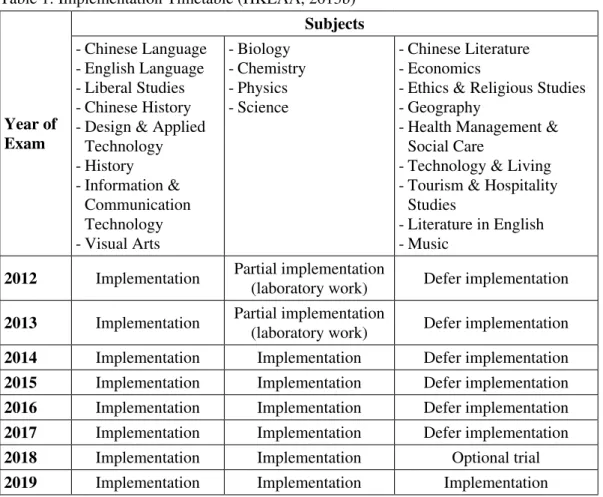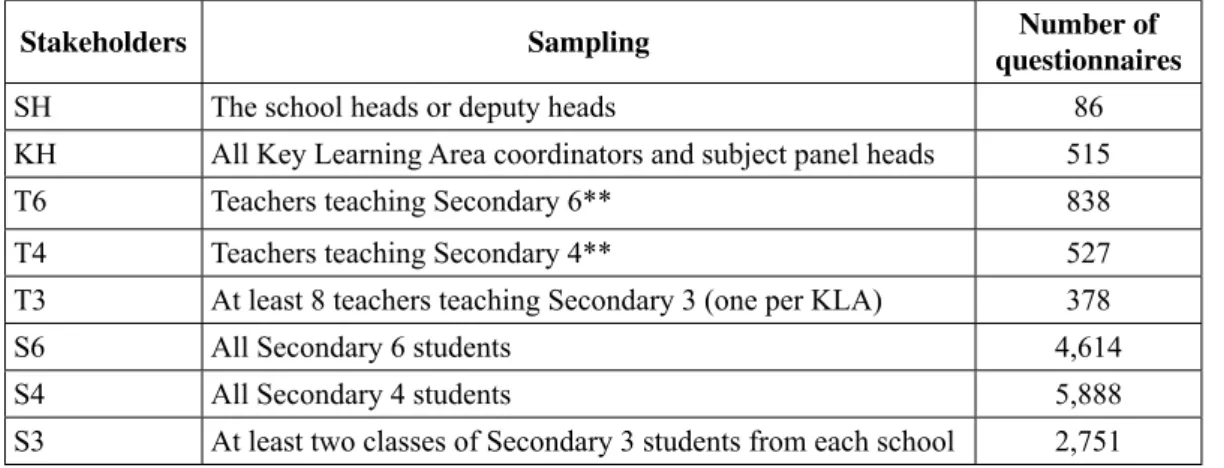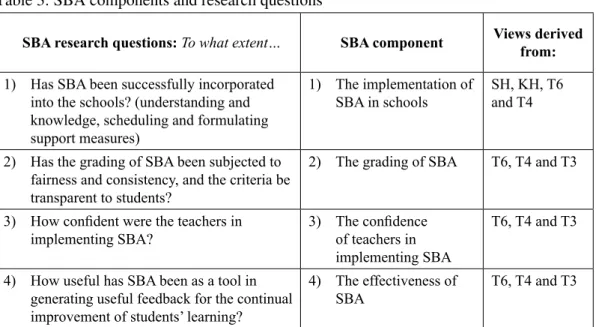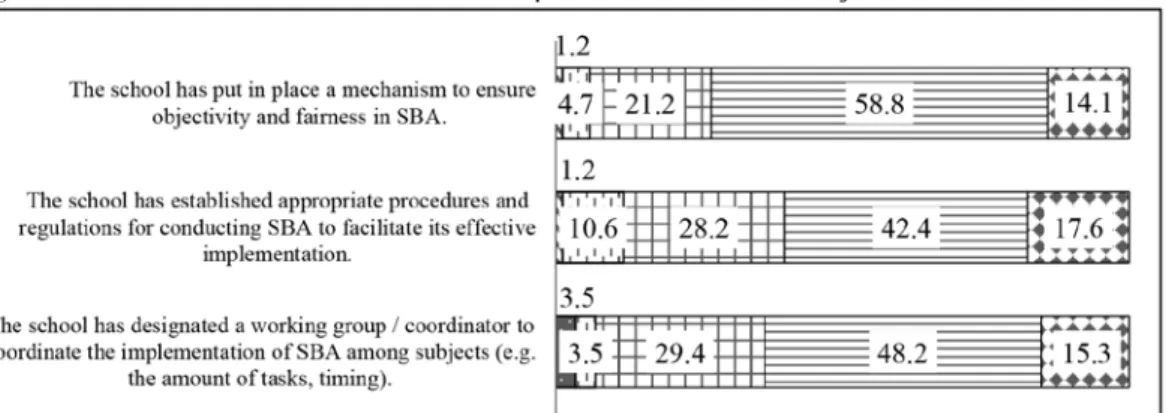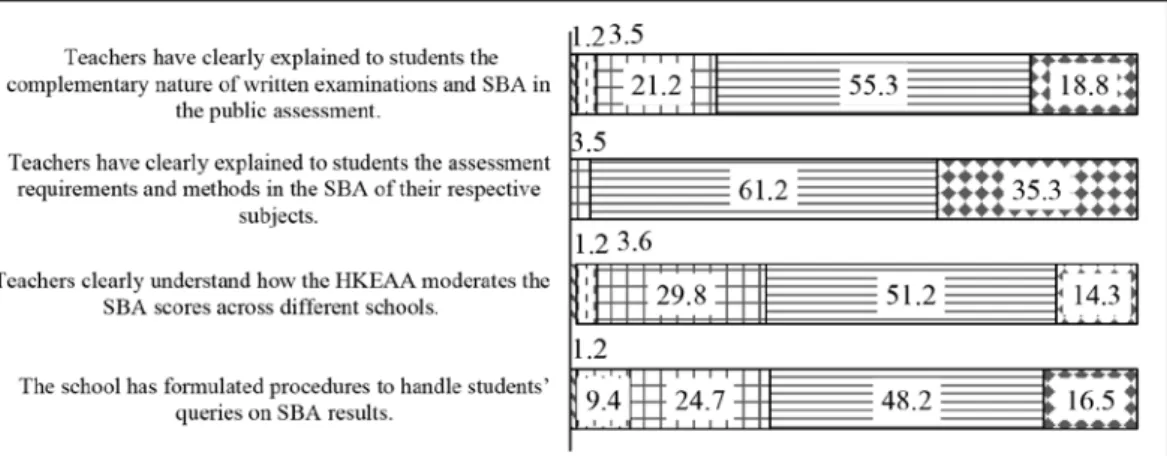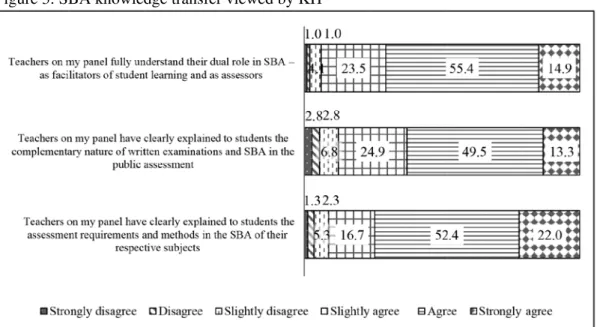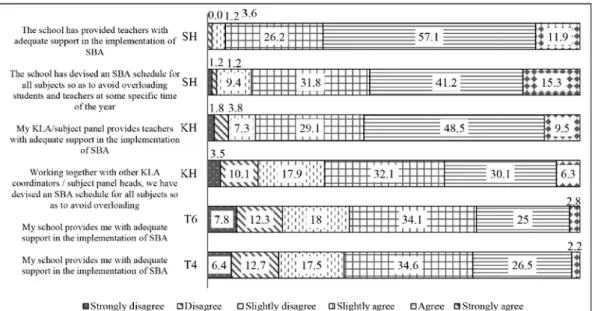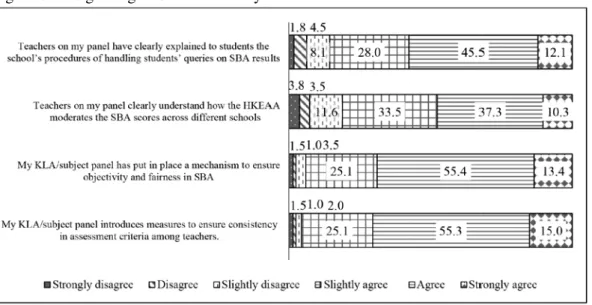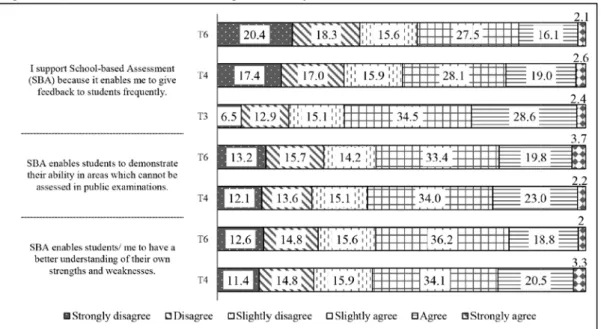Perspectives of school-based assessment
in the NSS curriculum through the
eyes of the administrative and teaching
stakeholders in Hong Kong
S Y MAK Barley
Department of Curriculum and Instruction,
Faculty of Education, The Chinese University of Hong Kong
Abstract
School-based assessment (SBA) is a form of formative assessment involving feedbacks and appraisals to students based on their school-based projects; it enables students to identify and improve on their areas of weakness and teachers to adjust their teaching strategies accordingly (Organisation for Economic Co-operation and Development [OECD], 2005). SBA is still a relatively new concept for most senior secondary school subjects in Hong Kong – yet it is now heavily incorporated into Hong Kong’s New Senior Secondary (NSS) Curriculum since the introduction of the New Academic Structure (NAS) in 2009. SBA has spawned numerous debates on its efficacy in Hong Kong and worldwide. This study gives an overview of the current issues related to SBA in Hong Kong through the eyes of the administrative and teaching stakeholders by utilizing territory-wide data of 91 secondary schools in Hong Kong from the most recent NSS Curriculum Study conducted in 2011-12.
Keywords
school-based assessment (SBA), formative assessment, New Senior Secondary (NSS) curriculum, curriculum reform, Hong Kong education
1. Introduction
1.1 The current Hong Kong education system and school-based assessment
In light of the rising competitiveness of the global environment, the Hong Kong’s education sector recognizes its need to strengthen Hong Kong students’ adaptability, creativity, independent thinking and life-long learning capabilities, which were limited by the traditional education system that restrained students from maximizing their potential. As a result, the New Academic Structure (NAS) was introduced in 2009 as one of the most ambitious education reforms in Hong Kong’s education history.
The NAS reduced the number of secondary school years from 7 to 6, and increased the number of tertiary education years from 3 to 4: Hong Kong students are now required to study three years in junior secondary school, three years in senior secondary school, and four years in the tertiary education sector – a “3-3-4” education system. Under this configuration, the New Senior Secondary (NSS) Curriculum was implemented as the framework for governing the content of the senior secondary school years (Secondary 4 to 6). As opposed to the traditional senior secondary school curriculum, NSS involved a number of major changes, which consisted of designating Liberal Studies as one of the four core subjects, the introduction of the elective subject system, as well as an emphasis on Other Learning Experiences (OLE) – to name but a few.
Major changes have also taken place in the assessment environment for senior secondary school students: the current education system has now shifted from a two-fold public examination system – the Hong Kong Certificate of Education Examination (HKCEE) and Advanced Levels (AL) in Secondary 5 and Secondary 7 respectively to a single public examination, the Hong Kong Diploma of Secondary Education (HKDSE) in Secondary 6. Meanwhile, as both an assessment and reviewing tool for teachers and students, school-based assessment (SBA) was incorporated and is now playing a pivotal role in giving greater emphasis to formative assessment (as opposed to summative assessment) in the NSS Curriculum. Notwithstanding its great potential in realizing the aims and virtues of the NAS, SBA poses great challenges and complexities in its application. In this paper, the progress of the implementation of SBA in the Hong Kong context will be reviewed and discussed through the eyes of administrators and teaching stakeholders.
1.2 The implementation of SBA in the NSS curriculum
In Hong Kong, SBA is an assessment administered in schools as part of the learning and teaching process, with senior secondary students being assessed by their subject teachers (Hong Kong Examinations and Assessment Authority [HKEAA], 2012a). In total, it accounts for 20% of the students’ overall HKDSE Examination result. From 2012, SBA was incorporated in 12 subjects including Chinese Language, English Language, Liberal
Studies, Chinese History, History, Biology, Chemistry, Physics, Science, Information & Communication Technology, Design & Applied Technology, and Visual Arts. According to the Hong Kong Examinations and Assessment Authority (HKEAA) (2013b), SBA will be extended gradually to other subjects starting from the 2014 HKDSE Examination, as indicated in Table 1 below:
Table 1: Implementation Timetable (HKEAA, 2013b)
Year of Exam Subjects - Chinese Language - English Language - Liberal Studies - Chinese History - Design & Applied Technology - History - Information & Communication Technology - Visual Arts - Biology - Chemistry - Physics - Science - Chinese Literature - Economics
- Ethics & Religious Studies - Geography
- Health Management & Social Care
- Technology & Living - Tourism & Hospitality
Studies
- Literature in English - Music
2012 Implementation Partial implementation (laboratory work) Defer implementation
2013 Implementation Partial implementation
(laboratory work) Defer implementation
2014 Implementation Implementation Defer implementation
2015 Implementation Implementation Defer implementation
2016 Implementation Implementation Defer implementation
2017 Implementation Implementation Defer implementation
2018 Implementation Implementation Optional trial
2019 Implementation Implementation Implementation
The intention of HKEAA is to slowly incorporate SBA in most subjects (not implemented in Mathematics and Business, Accounting & Financial Studies while practical examination is implemented for Physical Education instead), in a progressive and gradual manner year on year, while reviews, research and public consultations are simultaneously ongoing as adjustments are expected during the implementation process. Due to the demanding nature of SBA (as explained in the previous section), HKEAA has responded with a list of streamlining measures in order to alleviate the current situation and to provide room for the future implementation of SBA in other subjects. These streamlining measures are as follows:
1) The SBA of Chinese Language and Liberal Studies will be “streamlined” (i.e. the reduction of the number of tasks, assessments and mark submissions in the SBA of subjects) in the 2013 HKDSE Examination;
2) For the 9 deferred subjects where SBA was originally scheduled to be implemented between 2014 and 2016, full implementation will be postponed to the 2019 HKDSE Examination, with optional school trials to be conducted in 2018.
(HKEAA, 2013b) To better understand the needs of the education sector, HKEAA, the Curriculum Development Council (CDC) and the Education Bureau (EDB) are working in close collaboration to gauge the views of schools, curriculum development and subject experts, as well as independent education institutions in the streamlining proposals since October 2011. These proposals include streamlining the SBA of the 9 subjects that are scheduled in the 2014 HKDSE Examination, advancing SBA streamlining in Chinese Language to the 2013 cohort and adopting interim measures for Liberal Studies, and postponing the implementation of SBA of the 9 deferred subjects to the 2019 HKDSE Examination (HKEAA, 2013b).
1.3 Why school-based assessment?
SBA is by no means a new assessment tool; it is widely accepted and comprehensively implemented in countries such as Australia, New Zealand, England, Scotland, Canada and South Africa. SBA is regarded as a tool to more accurately reveal the true ability of the student, reduce the limiting effects of “exam fright”, and to increase the confidence of students as they have already learnt and brought to practice the examination contents and skills during the conduct of their SBA projects. In addition to this, students can also feel less anxious as they have already achieved a certain percentage of the final mark prior to their final exam (Kerr-Phillips, 2007). SBA is similarly viewed in Hong Kong as an integral component of teaching and learning, which made feedback and comprehensive appraisals possible, thus allowing both teachers and students to identify the latter’s strengths and weaknesses for the purpose of continual improvements and confidence building (HKEAA, 2012b). In addition, SBA is also proven to have positive effects on students’ public oral examination and better absentee rate than students from schools that do not submit SBA marks (Lee, 2009).
Yet SBA is not without its problems and controversies. As indicated by a report published by the Hong Kong Professional Teachers’ Union (PTU) in 2013, workload brought upon by SBA is overwhelming for both teachers and students. For the student, the demand for SBA is high in terms of its quality and quantity, sometimes exceeding that of a student’s ability (may even include tertiary education level contents). In addition, the heavy workload derived from SBA often incur extra lesson time, therefore limits students
from partaking in extracurricular activities. On the other hand, teachers are similarly affected by hosting the extra lessons, and marking the vast amount of students’ SBA work. Furthermore, the PTU report suggested that the inadequate proportion of SBA that makes up the final mark will ultimately be “unfairly” adjusted by the public paper examination, regardless of how well the student did in the former. In light of the above, some teachers have even suggested that SBA may negatively affect the quality of learning and teaching as a whole in Hong Kong (Hong Kong Professional Teachers’ Union, 2013).
Echoing these negative views, the sheer amount of workload of SBA has led to another major issue in other countries – plagiarism; it is tempting for students to copy work off the internet in order to save time amidst a tight schedule and demanding workload, thus incurring further workload for teachers in cross-checking references. Not only are the students tempted to play outside the rules, teachers are also reported to have meddled with the grey areas of the SBA grading system in order to achieve better grades for their students. Even without the deliberate intention of providing lenient markings, teachers call for a more standardized grading system for SBA across subjects in view of the “appalling partiality” in this aspect (Kerr-Philips, 2007). On an extreme note, Michael Gove, the Minister of Education in England remarked at the London Festival of Education in 2012, when questioned on the efficacy of SBA, “if education can’t be externally assessed, it’s play”, thus his recent initiatives to downplay the role of SBA enhance summative assessments in the UK (Downs, 2012).
In spite of the downside of SBA, it is still, no doubt, a tool to diversify the traditionally summative assessment tools (i.e. public paper examinations); it gives formative assessment a larger role for achieving continuous reviews on teaching practices, and sustainable improvement on the holistic learning and teaching environment. This paper will seek to provide an insight to the voices of the administrative and teaching stakeholders in order to provide an overview of the extent of success and acceptance of the implementation of SBA in Hong Kong’s NSS Curriculum.
2. Background of the study
In 2011, the EDB of Hong Kong Special Administration Region commissioned the Centre for Enhancing English Learning and Teaching (CEELT) of the Faculty of Education of The Chinese University of Hong Kong to undertake a major research project entitled New Senior Secondary Curriculum Implementation Study 2011 to reveal the progress made from implementing NSS. The study aimed at investigating various aspects of the NSS in 6 major themes, namely “Curriculum Planning”, “Learning and Teaching”, “Assessment”, “Managing Change”, “the Impact on Senior Secondary School Students”, and “Ongoing Needs and Concerns”. This paper will report on the findings related to SBA, a major theme under “Assessment”.
3. Methodology
The NSS study selected 105 schools out of a pool of 447 secondary schools in Hong Kong by a stratified random sampling technique based on an objective indicator of student achievement (Group 1 are schools with the highest average student achievement, Group 2 the next highest and Group 3 is the lowest). In the end, 91 out of the 105 schools responded to the request to participate in the survey, thus spawning a high response rate of about 87%.
The questionnaires were developed to gauge the views of the implementation of NSS from 6 different stakeholders; including School heads or deputy heads (SH), Key Learning Area coordinators and subject panel heads (KH), Secondary 6, 4 and 3 teachers (T6, T4 and T3), as well as Secondary 6, 4 and 3 students (S6, S4 and S3). The questionnaires were sent to the 91 schools and were administered by the schools’ personnel. The completed questionnaires were then returned by post between December 2011 and February 2012. The distribution of the returned questionnaires among the stakeholders is listed in Table 2 below:
Table 2: Number of questionnaires returned from different stakeholders
Stakeholders Sampling questionnairesNumber of
SH The school heads or deputy heads 86
KH All Key Learning Area coordinators and subject panel heads 515
T6 Teachers teaching Secondary 6** 838
T4 Teachers teaching Secondary 4** 527
T3 At least 8 teachers teaching Secondary 3 (one per KLA) 378
S6 All Secondary 6 students 4,614
S4 All Secondary 4 students 5,888
S3 At least two classes of Secondary 3 students from each school 2,751
* For subjects comprising a compulsory part and elective modules, teachers who teach only elective modules are not required to complete the questionnaire.
** Some of the teachers placed themselves as T4 and T6, thus the data were counted for both stakeholders.
SBA was a major theme under “Assessment” and since this paper seeks to identify the extent of how well SBA is incorporated into the administrative and teaching processes of the NSS Curriculum, this paper has drawn data only from the administrative and teaching stakeholders’ (SH, KH, T6, T4 and T3) views on SBA therein. The contents
of the questions on SBA were similar but tailored to each stakeholder (Appendix).The
questions on SBA were grouped into 4 major components designed to answer the research questions presented in the following table:
Table 3: SBA components and research questions
SBA research questions: To what extent… SBA component Views derived from:
1) Has SBA been successfully incorporated into the schools? (understanding and knowledge, scheduling and formulating support measures)
1) The implementation of
SBA in schools SH, KH, T6 and T4
2) Has the grading of SBA been subjected to fairness and consistency, and the criteria be transparent to students?
2) The grading of SBA T6, T4 and T3
3) How confident were the teachers in
implementing SBA? 3) The confidence of teachers in implementing SBA
T6, T4 and T3
4) How useful has SBA been as a tool in generating useful feedback for the continual improvement of students’ learning?
4) The effectiveness of
SBA T6, T4 and T3
The results and analysis section will be presented by bar charts in order to aid readers in visualizing the obtained data that are attached in the annexes of this study.
4. Results and analysis
The incorporation of SBA into the senior high school curriculum is a relatively new one for most subjects and requires understanding and adaptability on the part of the schools and teachers in this period of transition. The procedures adopted by schools to ensure an effective implementation of SBA, knowledge transfer of SBA (i.e. from school to teachers and from teachers to students) and the support provided to the teachers by the schools are inextricable factors determining the success of the implementation of SBA in the NSS Curriculum. In this light, this section will look at the perception of the administrative and teaching stakeholders – SH, KH, T6 and T4 – to gauge the extent of assimilation of SBA into the NSS Curriculum in terms of the above aspects.
A 6-point Likert scale was used to gauge the attitudes of stakeholders running from “strongly disagree” to “strongly agree”. The latter 3 points were used to calculate positive responses i.e. “slightly agree”, “agree”, “strongly agree”. Since the implementation of SBA is a new feature in the NAS, any positive responses are deemed significant, thus “slightly agree” is incorporated in the reporting of positive results.
4.1 Procedures adopted by schools to ensure effective implementation of SBA
in items (in descending order): “The school has put in place a mechanism to ensure objectivity and fairness in SBA” (SH: 94.1%), “The school has designated a working group / coordinator to coordinate the implementation of SBA among subjects (e.g. the amount of tasks, timing)” (SH: 92.9%), “The school has established appropriate procedures and regulations for conducting SBA to facilitate its effective implementation” (SH: 88.2%).
Figure 1: Procedures to ensure effective implementation of SBA by SH
While the majority of the schools have implemented procedures and regulations for the effective implementation of SBA on a wider scale, they have also demonstrated micro management planning by assigning working groups and coordinators to manage smaller items among subjects.
4.2 SBA knowledge transfer
The implementation of SBA can never be successful without the proper guidance provided to the teachers by HKEAA and their respective schools. Thus HKEAA has pledged to provide detailed guidelines, assessment criteria and exemplars to schools and teachers to ensure consistency in SBA grading, and as well as the provision of professional training and district coordinators to support schools and teachers to successfully implement SBA in the NSS curriculum (HKEAA, 2013a). In light of this, the acquiring and transferring of SBA information among stakeholders (i.e. from schools to teachers and from teachers to students) will be looked at. In this section, “SBA knowledge transfer” refers to both the acquiring and transferring of SBA information (e.g. assessment criteria, SBA weighting, number of SBA tasks, etc.) among stakeholders.
According to the responses from SH, shown in Figure 2 below, the findings provided positive evidence of the schools having enabled the knowledge transfer of SBA information to other stakeholders in secondary schools. High agreement levels were
found in the items (in descending order): “Teachers have clearly explained to students the assessment requirements and methods in the SBA of their respective subjects” (SH: 100.0%) was rated highest, followed by “Teachers have clearly explained to students the complementary nature of written examinations and SBA in the public assessment” (SH: 95.3%), “Teachers clearly understand how the HKEAA moderates the SBA scores across different schools” (SH: 95.3%), and “The school has formulated procedures to handle students’ queries on SBA results” (SH: 89.4%).
Figure 2: SBA knowledge transfer viewed by SH
Similarly, KH have responded with highly positive feedback on the transfer of SBA knowledge among teachers and students. In descending order: “Teachers on my panel fully understand their dual role in SBA – as facilitators of student learning and as assessors” (KH: 93.8%) was rated highest, followed by “Teachers on my panel have clearly explained to students the assessment requirements and methods in the SBA of their respective subjects” (KH: 91.1%), and “Teachers on my panel have clearly explained to students the complementary nature of written examinations and SBA in the public assessment” (KH: 87.7%), as indicated in Figure 3 below:
Figure 3: SBA knowledge transfer viewed by KH
By the same token, T6 responded with highly positive feedback in the following items, in descending order “I have clearly explained to students the assessment requirements and methods in the SBA of my subject” (T6: 93.6%), and “I have clearly explained to students the complementary nature of written examinations and SBA in the public assessment” (T6: 84.7%), as indicated in Figure 4 below:
Figure 4: SBA knowledge transfer viewed by T6
According to SH as well as KH, their teachers have demonstrated a clear knowledge in understanding the contents of SBA (e.g. how HKEAA would moderate SBA scores across different schools) and have taken up a dual role as both a facilitator and an assessor. With such knowledge, teachers were able to help students in resolving their queries on SBA-related matters, guide them through the assessment requirements and methods in their respective SBA subjects, and explain to them the complementary nature of written
examinations and SBA in the public assessment. T6 on the other hand, have provided the same positive findings at the teaching level.
4.3 SBA support provided to teachers
This section looks at the perceived support implemented and received by the administrative and teaching stakeholders in regard to the implementation of SBA. According to Figure 5 below, SH felt that “the school provides teachers with adequate support in the implementation of SBA” (SH: 95.2%) and that “the school has devised an SBA schedule for all subjects so as to avoid overloading students and teachers at some specific time of the year” (SH: 88.3%). Meanwhile, KH have responded with similar high levels of agreement to item “My KLA/subject panel provides teachers with adequate support in the implementation of SBA” (KH: 87.1%), but relatively lower in “Working together with other KLA coordinators / subject panel heads, we have devised an SBA schedule for all subjects so as to avoid overloading students and teachers at some specific time of the year” (KH: 68.5%). On the other hand, although more than half of T6 and T4 have responded with positive feedback to item “My school provides me with adequate support in the implementation of SBA” (T6: 61.9%, T4: 63.3%), a significant 40% have responded otherwise.
Figure 5: SBA support viewed by SH, KH, T6 and T4
It is noteworthy to highlight the significant differences on the level of perceived school support provided for the teachers among SH and the teaching stakeholders (T6 and T4) – although SH may feel that they have provided enough, the frontline teachers may still feel more support is needed as the workload from SBA is high. The findings reveal
that KH should also collaborate more with KH from other subjects so as to devise SBA schedules in avoiding the overloading of work.
4.4 The grading of SBA
In light of the autonomy given to teachers in grading their students’ SBA works, standardization is a crucial factor in determining fairness and minimizing discrepancies in students’ marks among both teachers and between schools, thus allowing a more accurate and better reflection on the quality of the students’ works accordingly. The information on the marking requirements of SBA works is essential to students, therefore such knowledge must be readily transferable and transparent. This section will look at the extent to which KH have ensured fairness in SBA grading at their schools and whether they and T6 have made SBA knowledge transferable to students.
The findings revealed that the vast majority of Key Learning Area coordinators and subject panel heads (KH) have taken into consideration and have ensured that there is reliability and fairness in SBA results. They adopted different measures as follows (in descending order): “My KLA/subject panel introduces measures to ensure consistency in assessment criteria among teachers” (KH: 95.4%), “My KLA/subject panel has put in place a mechanism to ensure objectivity and fairness in SBA” (KH: 93.9%), “Teachers on my panel have clearly explained to students the school’s procedures of handling students’ queries on SBA results” (KH: 85.6%), and “Teachers on my panel clearly understand how the HKEAA moderates the SBA scores across different schools” (KH: 81.1%), Figure 6 below:
On the other hand, T6 have revealed their efforts in handling SBA queries (in descending order): “I have already explained to students the school’s procedures of handling students’ queries on SBA results” (T6: 86.3%) and “I have clearly explained to students how the HKEAA moderates the SBA scores in my school” (T6: 81.6%), as indicated in Figure 7 below:
Figure 7: The grading of SBA viewed by T6
It is a discernible fact that the grading of SBA is viewed by both KH and T6 to have been ensured in its fairness; mechanisms were in place to ensure objectivity and consistency in assessment criteria among teachers. Meanwhile, schools’ procedures of handling students’ queries on SBA results have been clearly explained to the students, suggesting that students were provided with and were knowledgeable about obtaining information on their SBA results. Furthermore, it is noteworthy to mention that the majority of KH perceived their teachers to have understood how HKEAA would moderate SBA scores across different schools, and that the majority of T6 have made the marking criteria available to their students at their respective schools.
4.5 The effectiveness of SBA
One of the intended functions of SBA is to enable teachers to provide feedback and comprehensive appraisals to students, thus allowing students to understand and improve on their areas of weakness. In addition to this, SBA can allow students to demonstrate their strengths - that are often neglected in traditional public examinations (e.g. presentation skills). This section looks at the extent to which feedback and the demonstration of students’ alternative skills are enabled by the implementation of SBA in the NSS Curriculum.
As indicated by Figure 8 below, only around 50%-65% of stakeholders (T6, T4 and T3) agreed about the perceived benefits of SBA: “SBA enables students / me to have a better understanding of their own strengths and weaknesses” (*T6: 57.0%, T4: 57.9%), “SBA enables students to demonstrate their ability in areas which cannot be assessed in public examinations” (*T6: 56.9%, T4: 59.2%), and “I support School-based Assessment
(SBA) because it enables me to give feedback to students frequently” (*T6: 45.7%, T4: 49.7%, T3: 65.5%).
Figure 8: SBA feedback for learning viewed by T6, T4, and T3
The opinions of the teachers varied in the use of SBA as a feedback tool for students – while about 65% of T3 felt that SBA enabled them to provide useful feedback for students on a frequent basis, half of T4 and more than half of T6 felt otherwise. The use of SBA in enabling students in better understanding their own strengths and weaknesses and as a means to demonstrate their ability in areas not assessed in public examinations were rated relatively more positively by T6 and T4, despite a significant portion (about 40%) of them feeling that SBA could not do so.
Although a significant portion of teachers were able to improve the learning and teaching environment by effectively implementing SBA, the results revealed that there are factors hindering some teachers from doing so. As a preliminary observation, these factors may include the overburdening of workload derived from SBA that prevented teachers from having the needed time to provide feedback for their students.
4.6 The confidence of teachers teaching Secondary 4 and the extent of success in implementing SBA by teachers teaching Secondary 6
Teachers’ confidence in implementing SBA can reveal their knowledge and understanding of SBA in bringing it to fruition; likewise, the lack in such confidence may also suggest their concerns in the implementation process. The scales of T4 (confidence scale) and T6 (agreement scale) are different due to their respective nature - of the lack of
experience in implementing SBA for T4, as opposed to the experienced T6.
The findings suggested that the majority of T4 were comfortable in implementing SBA related tasks, as revealed by the high ratings in the following items (in descending order): “clearly explain to students the assessment requirements and methods in the SBA of my subject” (T4: 80.4%), “clearly explain to students the complementary nature of written examinations and SBA in the public assessment” (T4: 78.5%), “design effective SBA tasks to improve student learning” (T4: 77.4%), and “clearly explain to students how the HKEAA moderates the SBA scores in my school” (T4: 74.2%). It is noted that the item “handle the workload brought about by SBA” (T4: 59.1%) was rated relatively lower than the above, indicating that about 40% of T4 were not confident with their handling of workload derived from SBA, as indicated in Figure 9 below:
Figure 9: Teachers’ confidence in SBA implementation viewed by T4
Meanwhile, the majority of T6 agreed to the items (in descending order): “I have designed effective SBA tasks to facilitate student learning” (T6: 77.8%), and “So far I have been able to implement SBA smoothly” (T6: 68.7%). However, less than 50% of T6 agreed with the item “I can handle the workload brought about by SBA” (T6: 45.8%), suggesting they are facing difficulties in handling workload derived from SBA, as indicated in Figure 10 below:
Figure 10: Teachers’ confidence in SBA implementation viewed by T6
This section has suggested that the majority of T4 have confidence in designing effective SBA tasks to facilitate student learning, were able to implement SBA smoothly, and have clearly explained to students the contemporary nature of written examinations and SBA in the public assessment as well as how the HKEAA moderates the SBA scores in their schools. In addition, T6 have revealed that they have designed effective SBA tasks to facilitate student learning and were able to implement SBA smoothly.
On the down side, workload derived from SBA was troubling T4, as indicated by their relatively lower confidence in handling this aspect. By the same token, more than half of T6 have revealed their inability in handling workload derived from SBA.
5. Discussion
The data reveal that the implementation of SBA in the NSS Curriculum has been a successful endeavor by both Government and the education sector at the administrative and teaching levels; at the administrative level, the majority of the major players - i.e. SH as well as KH of the education sector revealed that they have fully incorporated SBA into their schools; support measures were provided for teachers in the implementation of SBA, whereby working group and coordinators were designated to help teachers coordinate their subjects, and measures were employed to ensure fairness, objectivity and consistency in grading SBA works.
Meanwhile on the teaching level (T6, T4 and T3), teachers were well aware of their dual role in SBA (as facilitators of student learning and as assessors), whereby both teachers and students were also well informed of its contents, marking procedures (both by HKEAA and the school), and related information made readily available and transparent
at times of need. It is encouraging to see that the learning and teaching environment of the students was enhanced through the designing of effective SBA tasks.
Notwithstanding the above positive views from the major stakeholders, the implementation of SBA was met by perceptions of its overwhelming workload. Despite the schools’ effort in scheduling subjects so as to avoid overloading students and teachers at some specific time of the year, a significant portion of T4 were skeptical of their ability to handle SBA workload whilst more than half of T6 from the sample felt that they were unable to handle the vast amount of work derived from SBA. As a general observation still yet to be tested in future studies, SBA workload might be the cause for the limited use of SBA for producing feedback for identifying strengths and weaknesses in students, thus helping them in their learning progress.
To realize the goal of “learning and teaching with assessment” through the implementation of SBA (HKEAA, 2013a), teachers should undergo professional training in understanding the curriculum’s learning goals and related criteria so as to place further emphasis in producing assessment feedbacks for students – as the streamlining of SBA should provide more time for teachers to do so. And as suggested by Harlen (2004), the development of an assessment community is essential for allowing a constructive and positive discussion on SBA, in which different intra- and inter-school stakeholders among various geographical settings can contribute to this community. These discussion topics may include the distribution of resources, intra- and inter-school moderation standardization, teacher assessment, and ongoing professional trainings etc., so as to promote quality assurance for SBA.
6. Conclusion
To maximize the benefits derived from the implementation of SBA, both the education sector and the Government bodies must identify the causes for the limited use of SBA in producing feedback and appraisals for the holistic development of students’ learning profiles. The immense amount of SBA workload felt by the teachers cannot be neglected, thus HKEAA, CDC, EDB and as well as the education sector have worked hand in hand in improving this aspect of the NSS Curriculum, as seen by the recent streamlining measures in SBA subjects. The education sector has yet to experience these measures and studies are required in the future to identify the effectiveness therein.
As many believe in the high potential of what SBA can bring to the learning and teaching environment, an effective implementation of SBA in terms of its scheduling, standardization in grading, information flow and the overall support for both schools and teachers are inextricable components to the welfare and effective incorporation of SBA into the NSS Curriculum – in all of which the Hong Kong education sector has
demonstrated its professionalism in accomplishing these and its commitment to rising to new challenges.
Acknowledgements
The research reported in this study was supported by a grant from the EDB, Hong Kong Special Administrative Region. Any opinions, findings, conclusions or recommendations expressed in this article are those of the author and do not necessarily reflect the views of the EDB.
References
Downs, J. (2012). If it can’t be externally assessed, it’s play, Gove’s message to teachers. Retrieved from http://www.localschoolsnetwork.org.uk/2012/11/if-it-cant-be-externally-assessed-its-play-goves-message-to-teachers/
Harlen, W. (2004). Can assessment by teachers be a dependable option for summative purposes? Paper presented at General Teaching Council for England Conference, 29 November, 2004, London.
Hong Kong Examinations and Assessment Authority. (2012a). Definition of school-based assessment. Retrieved from http://www.hkeaa.edu.hk/DocLibrary/SBA/HKDSE/Eng_ DVD/sba_definition.html
Hong Kong Examinations and Assessment Authority. (2012b). Hong Kong Diploma of Secondary Education examination: Information on school-based assessment. Retrieved from http://www.hkeaa.edu.hk/DocLibrary/Media/Leaflets/SBA_pamphlet_E_web.pdf Hong Kong Examinations and Assessment Authority. (2013a). Booklet on HKDSE
examination - Information on school-based assessment. Retrieved from http://www. hkeaa.edu.hk/DocLibrary/Media/Leaflets/SBA_ pamphlet_E_web.pdf
Hong Kong Examinations and Assessment Authority. (2013b). Subject information on SBA. Retrieved from http://www.hkeaa.edu.hk/en/SBA/sba_hkdse/SBA_timetable.html
Hong Kong Professional Teachers’ Union. (2013).〈新高中問卷調查結果發布(2013)〉. Retrieved from http://www.hkptu.org/8896
Kerr-Phillips, F. (2007, August). School-based assessment: The need, the reality, the future: A perspective from the independent examinations board of South Africa. Retrieved from http://www.iaea.info/documents/paper_1162d20227.pdf
Lee, W. W. C. (2009). The beneficial wash-back of the school-based assessment component on the speaking performance of students. Hong Kong Teachers’ Centre Journal, 8, 18-29. Retrieved from http://edb.org.hk/HKTC/download/journal/j8/(5)HKTCJ08-Article1-2.pdf Organisation for Economic Co-operation and Development. (2005). Teachers matter:
Attracting, developing and retaining effective teachers. Retrieved from http://www.oecd. org/education/school/34990905.pdf
Questionnaire for School Heads / Deputy Heads (SH)
New Senior Secondary (NSS) Curriculum Implementation Study 2011*
*This section is extracted from the NSS questionnaire for the purpose of this paper.
Dear School Heads / Deputy Heads,
The Education Bureau (EDB) has commissioned The Chinese University of Hong Kong to conduct the Study on the Implementation of the New Senior Secondary (NSS) Curriculum. As part of the Study, we would like to collect your views which would provide information for the EDB to strengthen school support and improve the effectiveness of implementation. Please be assured that the questionnaire will be kept strictly confidential and anonymous. All collected information will be used exclusively for evaluating the implementation of the NSS curriculum, and no reference will be made to any individual information. Thank you.
Centre for Enhancing English Learning and Teaching (CEELT) Faculty of Education The Chinese University of Hong Kong ________________________________________________________________________
To what extent do you agree that the items below describe curriculum implementation in
your school since the 2009/10 school year?
Strongly disagree Disagree Slightly disagree Slightly agree Agree Strongly agree
School-based Assessment (SBA)
1. SBA has become an integral part of the school’s internal assessment.
2. The school provides teachers with adequate support in the implementation of SBA. 3. Teachers have clearly explained to students
the complementary nature of written examinations and SBA in the public assessment.
To what extent do you agree that the items below describe curriculum implementation in
your school since the 2009/10 school year?
Strongly disagree Disagree Slightly disagree Slightly agree Agree Strongly agree
4. Teachers have clearly explained to students the assessment requirements and methods in the SBA of their respective subjects.
5. Teachers clearly understand how the HKEAA moderates the SBA scores across different schools.
6. The school has designated a working group / coordinator to coordinate the implementation of SBA among subjects (e.g. the amount of tasks, timing).
7. The school has devised an SBA schedule for all subjects so as to avoid overloading students and teachers at some specific time of the year.
8. The school has established appropriate procedures and regulations for
conducting SBA to facilitate its effective implementation.
9. The school has put in place a mechanism to ensure objectivity and fairness in SBA. 10. The school has formulated procedures to
Questionnaire for Key Learning Area coordinators and
subject panel heads (KH)
New Senior Secondary (NSS) Curriculum Implementation Study 2011*
*This section is extracted from the NSS questionnaire for the purpose of this paper.
Dear Key Learning Area coordinators and subject panel heads,
The Education Bureau (EDB) has commissioned The Chinese University of Hong Kong to conduct the Study on the Implementation of the New Senior Secondary (NSS) Curriculum. As part of the Study, we would like to collect your views which would provide information for the EDB to strengthen school support and improve the effectiveness of implementation. Please be assured that the questionnaire will be kept strictly confidential and anonymous. All collected information will be used exclusively for evaluating the implementation of the NSS curriculum, and no reference will be made to any individual information. Thank you.
Centre for Enhancing English Learning and Teaching (CEELT) Faculty of Education The Chinese University of Hong Kong ________________________________________________________________________
To what extent do you agree that the items below describe how your KLA / subject panel implements learning and teaching strategies
since the 2009/10 school year? Strongly disagree Disagree Slightly disagree Slightly agree Agree Strongly agree
School-based Assessment (SBA)
1. SBA has become an integral part of the
internal assessment in my KLA/subject. 2. My KLA/subject panel provides teachers
with adequate support in the implementation of SBA.
3. Teachers on my panel fully understand their dual role in SBA – as facilitators of student learning and as assessors.
To what extent do you agree that the items below describe how your KLA / subject panel implements learning and teaching strategies
since the 2009/10 school year? Strongly disagree Disagree Slightly disagree Slightly agree Agree Strongly agree
4. Teachers on my panel have clearly explained to students the complementary nature of written examinations and SBA in the public assessment.
5. Teachers on my panel have clearly explained to students the assessment requirements and methods in the SBA of their respective subjects.
6. Teachers on my panel have clearly explained to students the school’s procedures of handling students’ queries on SBA results. 7. Teachers on my panel clearly understand
how the HKEAA moderates the SBA scores across different schools.
8. Working together with other KLA
coordinators / subject panel heads, we have devised an SBA schedule for all subjects so as to avoid overloading students and teachers at some specific time of the year.
9. My KLA/subject panel has put in place a mechanism to ensure objectivity and fairness in SBA.
10. My KLA/subject panel introduces measures to ensure consistency in assessment criteria among teachers.
Questionnaire for Teachers Teaching S4 (T4) and S6 (T6)
New Senior Secondary (NSS) Curriculum Implementation Study 2011*
*This section is extracted from the NSS questionnaire for the purpose of this paper.
Dear teachers,
The Education Bureau (EDB) has commissioned The Chinese University of Hong Kong to conduct the Study on the Implementation of the New Senior Secondary (NSS) Curriculum. As part of the Study, we would like to collect your views which would provide information for the EDB to strengthen school support and improve the effectiveness of implementation. Please be assured that the questionnaire will be kept strictly confidential and anonymous. All collected information will be used exclusively for evaluating the implementation of the NSS curriculum, and no reference will be made to any individual information. Thank you.
Centre for Enhancing English Learning and Teaching (CEELT) Faculty of Education The Chinese University of Hong Kong ________________________________________________________________________
To what extent do you agree with the following descriptions? (Please focus on the S4 / S6 subject you are mainly teaching this
school year.)
For T4 only For T6 only
Strongly disagree Disagree Slightly disagree Slightly agree Agree Strongly agree Strongly disagree Disagree Slightly disagree Slightly agree Agree Strongly agree
School-based
Assessment (SBA) [Items 1-4 are applicable to all S4 teachers except for Mathematics teachers]
[Items 1-11 are only applicable to S6 teachers who are mainly teaching the subjects that SBA will be implemented in 2012] 1. I support School-based Assessment (SBA) because it enables me to give feedback to students frequently.
To what extent do you agree with the following descriptions? (Please focus on the S4 / S6 subject you are mainly teaching this
school year.)
For T4 only For T6 only
Strongly disagree Disagree Slightly disagree Slightly agree Agree Strongly agree Strongly disagree Disagree Slightly disagree Slightly agree Agree Strongly agree 2. My school provides me with adequate support in the implementation of SBA. 3. SBA enables students to demonstrate their ability in areas which cannot be assessed in public examinations. 4. SBA enables students to have a better understanding of their own strengths and weaknesses. 5. I have designed
effective SBA tasks to facilitate student learning. 6. I have clearly explained to students the complementary nature of written examinations and SBA in the public assessment.
To what extent do you agree with the following descriptions? (Please focus on the S4 / S6 subject you are mainly teaching this
school year.)
For T4 only For T6 only
Strongly disagree Disagree Slightly disagree Slightly agree Agree Strongly agree Strongly disagree Disagree Slightly disagree Slightly agree Agree Strongly agree 7. I have clearly
explained to students the assessment requirements and methods in the SBA of my subject. 8. I have already explained to students the school’s procedures of handling students’ queries on SBA results. 9. I have clearly explained to students how the Hong Kong Examinations and Assessment Authority (HKEAA)
moderates the SBA scores in my school. 10. I can handle the
workload brought about by SBA. 11. So far I have been
able to implement SBA smoothly.
For T4 only
When I teach S5 in the
coming school year,
I am confident that I can…
Highly not confident Not confident Slightly not confident Slightly confident Confident Highly confident 12. design effective SBA tasks to improve student learning. 13. clearly explain to students the complementary nature of written examinations and SBA in the public assessment. 14. clearly explain
to students the assessment requirements and methods in the SBA of my subject. 15. clearly explain to
students how the HKEAA moderates the SBA scores in my school.
16. handle the workload brought about by SBA.
